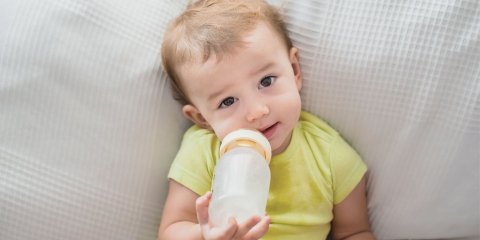Key Points
- When your baby is six months old, eating sold food, and confidently sitting in a high-chair, they're ready for a sippy cup.
- It's important to introduce a sippy cup as soon as possible after six months, as prolonged bottle use can cause dental and speech problems.
- Children should stop drinking formula altogether by the time they are 18 months old.
- If your child is used to a particular brand of bottle, find out if that brand also produces sippy cups.
- Once you've found a sippy cup that your child enjoys using, stick with this type and brand.
If your baby is partly or solely formula-fed, you may have had to try several different brands and types of teats before you found the perfect bottle that your baby could feed from. Then during the whirlwind of your baby's first year, it seems that everyone is talking about sippy cups. Is it really time to transition from bottles to formula in sippy cup?
Even though you may be reluctant to leave the bottle-feeding stage behind for good, studies show that bottles can cause dental and speech issues in young children. Babies as young as six months can - and should - begin transitioning from bottles to sippy cups, provided some important physical milestones have been met.
Read on to find out the importance of stopping bottle use as soon after six months as possible, and simple tips to easily transition your baby from bottles to sippy cups.
Can you put formula in a sippy cup? Putting formula in a sippy cup is totally fine. The transition to a sippy cup can begin after your child reaches 6 months of age. Using sippy cups promotes good oral hygiene and prevents speech issues that could develop.
Why Long-Term Bottle Use Is Not A Good Idea
It has long been understood that long-term pacifier use can cause dental problems . Similarly, it has now been shown that prolonged bottle use can contribute to dental problems.
The available scientific evidence showed that breastfeeding is more effective at preventing dental caries in early childhood than bottle feeding.
In particular, it is recommended that children do not continue to drink formula after 18 months and that they begin to transition away from bottles as soon as possible after six months of age, otherwise they risk dental and speech problems.
Knowing When Your Child Is Ready For A Sippy Cup
You can start to offer a sippy cup once your child is six months old - provided certain developmental milestones have been reached.

But of course, no two babies are the same, and children reach various milestones at different times. Here's how to determine if your baby is ready to move from a bottle to a sippy cup.
- Wait until at least six months of age, but don't worry if you feel your baby won’t be ready for a few more months yet. However, babies should be weaned off formula by the time they are 18 months of age, so keep this important timeframe in mind.
- If your baby can confidently sit up by themselves in a high-chair and have begun eating solid food, the time is right to introduce a sippy cup. Your baby should be consistently able to open their mouth in readiness for a spoon.
- Another good indication of readiness is when your baby is adept at grasping and holding onto objects tightly in their hands. This is an important skill necessary for sippy cup use.
Simple Tips To Help Your Child Transition From Bottle To Sippy Cup
Transitioning from a bottle to a sippy cup may not be a welcome process for you or your baby. To make the journey as smooth and stress-free as possible, consider the following tips:
- Use preferred brand - By now, your baby will probably have shown a preference for a particular brand of bottle. See if that brand also produces sippy cups, as the lips of the cup will likely have some similarities with the particular teat that your child enjoys. If your child doesn't take to this brand, try a few different brands until you find the right fit. Once your child is confidently drinking from their new sippy cup, stick with the one brand.
- Try tea or juice first - If your child is reluctant to consider the idea that milk can come from something other than a bottle, introduce a new taste in the sippy cup. By six months of age, your child is ready to start trying solid foods and can begin tasting liquids other than milk. Try water, a toddler safe tea , or even watered-down juice to pique their interest in the sippy cup.
- Time - Allow plenty of time for exploration. Your child will want to explore their new sippy cup just as they enjoy exploring toys and books. Let them feel the cup, chew it, and have time to get to know it before learning how to drink from it.
- Patience - Be patient and let your child determine the pace. If your child turns their head away, take that as a very clear signal that they've had enough. Promptly put the sippy cup out of sight and wait until the next mealtime (or even the next day) before offering it again. If your child feels pressured to master the cup straight away they could develop anxiety about it or even refuse to try on principle.
Avoiding Tooth Decay From Sippy Cups
While research shows that teeth problems can occur from prolonged bottle use in babies and toddlers, there are still certain precautions that must be taken when transitioning to formula in sippy cup.

Most importantly, ensure that your child only ever drinks from the sippy cup at mealtimes and doesn't get into the habit of walking around with a semi-full sippy cup of formula.
If your child gets into the habit of sipping formula throughout the day, they may come to rely on the sippy cup for comfort - in place of a thumb or pacifier. The ensure this doesn't occur, treat the sippy cup like a plate of food.
Just as you don't walk around your house nibbling from a plate of food all day long, ensure that your child doesn't fall into a similar habit. Meals should take place at the table, and only when your child is hungry. Ensure an adequately balanced meal containing plenty of vegetables for your child .
When your child leaves the table, the meal is over and any remaining formula in the sippy cup must be thrown away.
If you've loved the infant stage - or if this is your last baby - you may feel reluctant to move away from bottle feeding.
However, once your baby is at least six months old and able to confidently sit up in a high-chair, the time has come to introduce formula in sippy cup.
Not only will early cup transitioning help to prevent dental and speech problems often associated with prolonged bottle use, but tackling this important developmental task when your child is still a baby will prevent what could become a battle of wills during the stubborn and determined toddler years ahead.
With general advice being that babies should be completely weaned from the bottle by their first birthday, the earlier you start sippy cup usage, the easier this stage will be for everyone.
Resources
- https://www.aap.org/en-us/advocacy-and-policy/aap-health-initiatives/HALF-Implementation-Guide/Age-Specific-Content/Pages/Infant-Food-and-Feeding.aspx
- https://www.parents.com/baby/breastfeeding/weaning/bye-bye-bottle/
- https://www.whattoexpect.com/first-year/ask-heidi/introducing-sippy-cup.aspx
- https://www.ncbi.nlm.nih.gov/pmc/articles/PMC4651315/
- https://www.ncbi.nlm.nih.gov/pmc/articles/PMC2791559/

